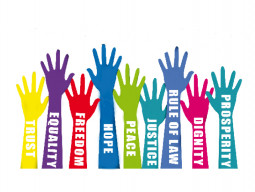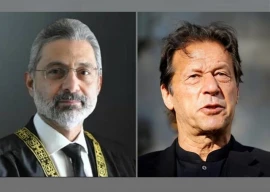
The United Nations Development Programme recently issued its flagship publication, the Human Development Report 2013. Pakistan has been grouped in the Low Human Development category, ranking 146 out of 186 countries — the position shared by Bangladesh and outshined by most of the other Saarc countries. The country registered zero growth on the Human Development Index compared with last year and relegated by only one rung between 2007 and 2012. Pakistan’s performance on key indicators merits serious introspection.
In the maternal mortality ratio category, Pakistan depicts a dismal picture as the number of dying mothers, 260 per 100,000 live births, is highest in the region, except for Afghanistan which has 460 deaths per 100,000 live births. Sri Lanka has the lowest number — 35.
For infant mortality rate, the country ranks the highest in the region. Out of every 1,000 live births, 70 infants die. Even the Congo has a lower number of such deaths — 61. Other Saarc countries have better records.
With regard to female populations with secondary education, Pakistan has only 18.3 per cent of women at or above 25 years of age with a secondary education. This is far better than Afghanistan’s 5.8 per cent but considerably behind India (26.6) and Sri Lanka (72.6).
In female labour force participation, all countries — except Nepal — have better female participation than Pakistan, with it being a mere 22.7 per cent. Bhutan has an impressive 65.8 per cent.
Regarding the percentage of population in severe poverty, this makes up 27.4 per cent of Pakistan’s population; slightly better than India with 28.6 per cent, yet far higher than Nepal’s 20.8, Bangladesh’s 8.5, Bhutan’s 5.8 and the Maldives’ only 0.3 per cent. Severe poverty has cascading implications that impair performance on other human development indicators.
With regard to social sector spending, Pakistan has a stingy spending record on health and education, which corroborates its lack of political will to improve human development indicators. Both key pillars of human development receive crumbs of the budget allocations. Pakistan spends only 0.6 per cent of GDP on health, which is even dwarfed by highly unstable Afghanistan with 3.9 per cent. Bhutan spends the highest on health in the region — 5.3 per cent. Even the Congo spends twice as much on health — 1.2 per cent. Ethiopia (2.3), Yemen (1.4), Rwanda (1.7), Sudan (2.8) and Nigeria (1.6) deride our image in the international community. Likewise, Pakistan spends only 2.4 per cent of its GDP on education, which is significantly lower than 5.8 per cent of Bhutan and 4.7 per cent of Nepal. The Congo appends 6.2 per cent on this account.
In the category of military spending, Pakistan has the highest in the region after Sri Lanka, 2.8 and three per cent of GDP, respectively. Juxtaposing military spending with the social sector speaks volumes about Pakistan’s misplaced priorities, which leave a large part of society ill and illiterate.
Finally, allotment of seat for women in parliament (per hundred seats) is the only indicator that assuages the country’s sheepish rankings. Pakistan has the second highest percentage of female parliament members in the region (19.7 per cent) and is followed by Afghanistan with 22.7 per cent. Proudly, it is much higher than India’s 10.9 per cent.
Published in The Express Tribune, April 20th, 2013.
COMMENTS (10)
Comments are moderated and generally will be posted if they are on-topic and not abusive.
For more information, please see our Comments FAQ

































































@Cobrajock: You are wrong! The 620,000 force did not grow in response to the "War on Terror".
For some background, Pakistan's colonial army has deep economic ties with the impoverished state, outside the realm of defense. It ruled the country for 32 years and if Air Marshals Nur Khan and Asghar Khan are to be believed, it lost both the 1965 and 1971 conflicts.
The War on Terror came to the plains of Pakistan under the aegis of General Musharraf who was duplicitous as he "prosecuted" the War, running, as he did, with the hare and hunting with the hounds. It was not him but the country that was left standing in the "line of fire".
@Cobrajock: If you look back 40 years..you can see cause & effect: -- Its the misplaced priorities that resulted in a macho military wanting to take on India in Kashmir and Soviets in Afghanistan. -- Result: In no other country can militants drive around on Toyota Trucks displaying their guns and rocket launchers. -- Subsequent result: you can afford to spend even less on education and health. This road is going nowhere...one day you have to turn back.... Just because you have traveled for 40 years on the wrong road, it does not justify another 40 years of going nowhere...
No one including the government of Pakistan knows the real expenditure on Defense as auditing of its accounts is not allowed. Therefore everyone can indulge in kite flying. Every country owns a military, but uniquely only one military owns a country.
most of the people commenting are saying corrupt politicians not spending on education. this is a very novice notion, we should think of army as well, may be they are totally against this cut in their budgets plus how much they are not corrupt we also don't know.
@Mirza:
You forget that Sri Lanka was in similar position fighting Tamil tigers for more than a decade, yet their literacy rate is higher than us & spends more on health than us....on the other hand our politicians are corrupt to the core & do not bother to make education a priority though it is FREE as per constitution....even identified & knowing fully well & conscious of the fact that there are thousands of ghost schools & teachers who are eating away the budget, yet no steps have been taken to resolve this glaring issue....why ! is there no corruption in Sri Lanka, but the difference is, they are eating 25% while we are eating 99 %....
Pakistan has the second highest percentage of female parliament members in the region (19.7 per cent) and is followed by Afghanistan with 22.7 per cent. Proudly, it is much higher than India’s 10.9 per cent.
Impressive achievement indeed. It would however be interesting to show the percentage of women parliamentarians who are NOT from the affluent strata of Pakistani society. I think there are hardly any from the lower strata or grass roots, considering those you see on the TV talk shows. India would do better on that score.
But, that would be true even of our men parliamentarians.
"percentage of population in severe poverty, this makes up 27.4 per cent of Pakistan’s population; slightly better than India with 28.6 per cent, yet far higher than Nepal’s 20.8, Bangladesh’s 8.5, Bhutan’s 5.8 and the Maldives’ only 0.3 per cent." When Bangladesh was a part of Pakistan it was the poorest province of Pakistan. They are benefiting from the dividends of freedom and in 40 years they are ahead of us. Right wing leaders keep making promises of increasing the education and healthcare expenses without ever giving the figure from a budget pie. Pakistan has made deliberate choice of nurturing the huge military and WMD while people are being killed by tense of thousands by home grown terrorists before they are killed by lack of healthcare and hunger. From Japan and Germany to Malaysia, BD, Bhutan, and other countries are investing on their people a greater amount of budget and their population is safe, health, happy, successful and living long lives. What is our investment on the non productive defense giving our people?
@ Rao Amjad Ali ........... The absolute necessity of spending on education, science and technology notwithstanding. May I ask you how you profess to use the nuclear deterrence against terrorism that we are fighting for a decade or more where the enemy is faceless?
Misplaced, Indeed! With nuclear deterence, it makes no sense to have to sustain a miltary of the size Pakistan has (for details see www.SIPRI.org).
We must commit much greater resources to education, science and technology in order to participate in the battle of ideas, not clamor for military misadventures such as Kargil or erroneously lean on Kasmir as a reason for the 620,000 force.
every country wants to spend more in education and health sector. Its typical rhetoric which does not represent popular sentiment in Pakistan. HEALTH/ EDUCATION ARE OUR NECESSITIES, BUT DEFENCE IS OUR COMPULSION, from which we can not turn our faces away. My dear Sir, the geo-strategic compulsions, especially what is happening around us, spells it out very clearly, that Defence spendings, are not "Misplaced" priorities